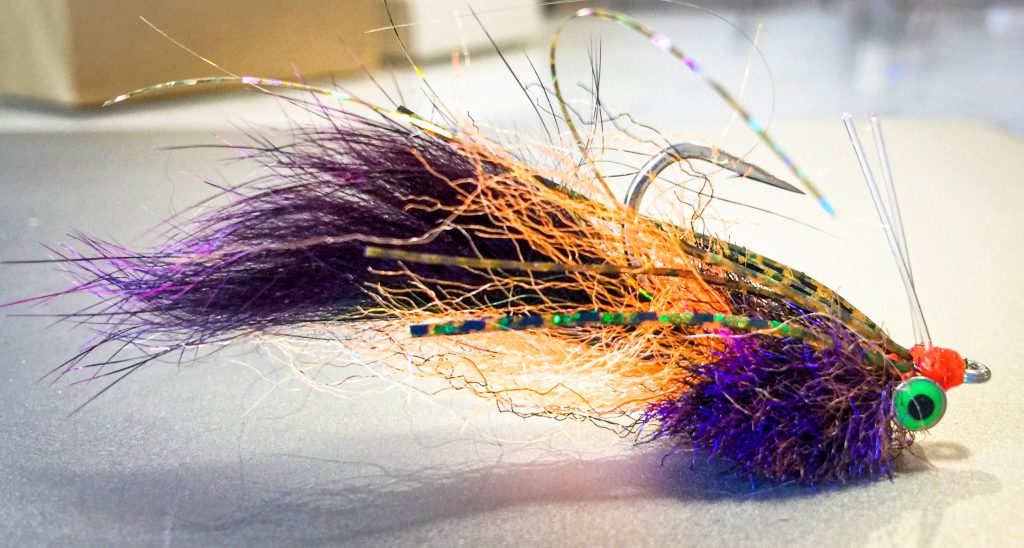My go to flies – Part 1
by John H. Holbrook
I have always been a keep it simple kind of guy, so it should be no surprise that there are only four fly patterns in my fly box during summertime when Redfish are tailing in the Lowcountry high marsh grass. Each has its own special purpose. I will start with my #1 pick and most productive overall.

This fly is tied to imitate one of the Redfish’s staples in his diet—Crabs. You see both fiddler crabs and juvenile stone crabs everywhere in the high marsh grass when wading on a hard bottom where only Black Needlerush and Salt Meadow Cordgrass grow. The day before a fishing trip, I leave my flies out in the sun on purpose to allow the sun’s UV rays to bleach out the bright purple and orange fly tying materials used at the tying vice. The faded colors enhance the fly’s appeal to Redfish. I can only guess why but this much I do know. Redfish will eat this fly every time during a spring flood tide in the Summer.
There are other factors more important than fly selection: 1.) How accurately you cast the fly; and 2.) How you retrieve it. When you are casting to a tailing redfish, you always want to cast in front of, and slightly beyond the target. How fast the fish is moving, and the conditions on the flat will dictate how far in front of the fish you cast. On a happy fish, I would normally cast this fly about 3 foot in front of, and 12-18 inches beyond the fish. This gives me time to react to any changes in the fish’s direction of movement, and allows me to move the fly so that it intersects the fish at about 12 inches away. Keep in mind that this is a crab pattern, think short quick strips with your line hand when you are moving it. These short quick strips make the fly jig up and down just like the real thing and keep the fly in the feeding zone longer. The clearer the water the farther you should lead the fish, and the farther you should cross the fly with the fish’s direction of movement. The prevailing conditions they will dictate what you do. Pay attention.
I was wade fishing a few years back after I got off of work, and we had had a brief but fierce thunder storm that had chased me off of the flat. It is not a good idea to be holding a graphite fly rod when the lightning cracks across the dark sky. I waited in the car, and when the lightning stopped, I got back out on the flat. As soon as I walked out, I had a nice ‘Tailer’ about 30 feet away. I positioned myself to make a good cast, and laid one down perfect about 3 feet in front of, and just beyond the fish. I moved that fly and crossed his eyes at 12 inches … and he completely ignored my fly. I waited for the fish to move past my fly, then I made another distance cast that was even more accurate this time. I would like to say that I was smart and figured out what was going on, but the truth is I started to pout and looking down at my feet I noticed that the water had ruined into chocolate milk because of the rainfall. So my next cast was about 6 inches in front of that fish, and the moment I moved the fly he crushed my Lowcountry Fiddler Crab Pattern. Good luck!
Lowcountry Fiddler Crab Fly Pattern
Materials List
- Thread: Danville Flat Waxed Nylon, Color: Fluorescent Orange
- Hook: Gamakatsu SC15, Size 1/0
- Eyes: Green Tungsten barbell style, Size Small
- Tail: Hareline Frost-Tip Rabbit strip, Color: Fuscia
- Butt: EP Tarantula 1” brush, Color: Hot Orange
- Body: EP Fibers, Blend Colors: Brown, Dark Brown, Black & Purple.
- Flash: Use very sparingly, just 2 strands along with legs.
- Legs: Hareline Crazy Legs, Color: Barred Dark Olive
- Weed Guard: 20 Lb. Hard Mason
Great info John – thank you! Just moved to Daniel Island and the info really helps in getting acquainted with the redfish here.